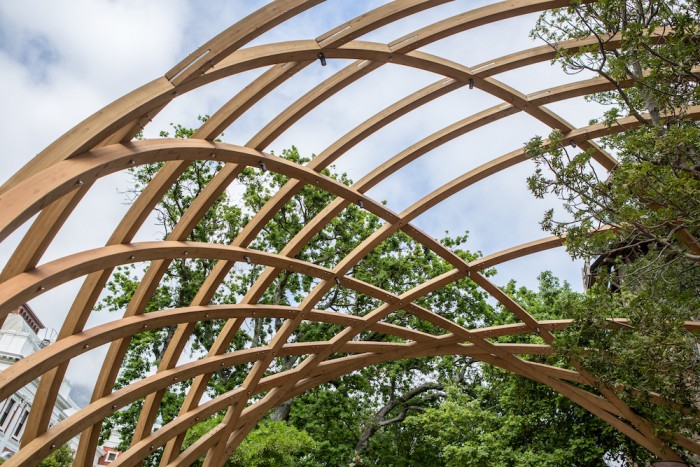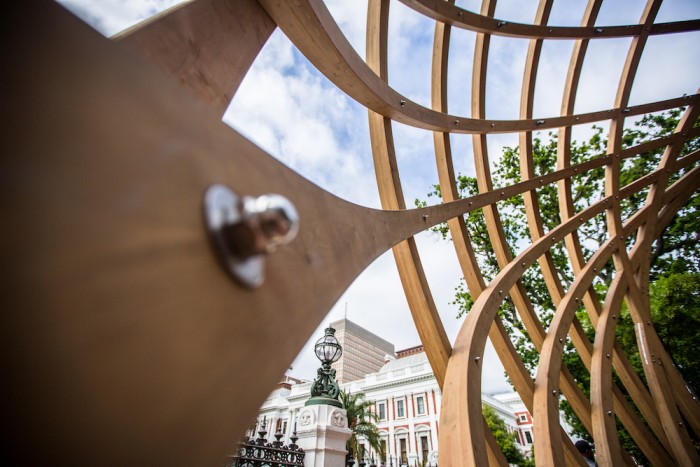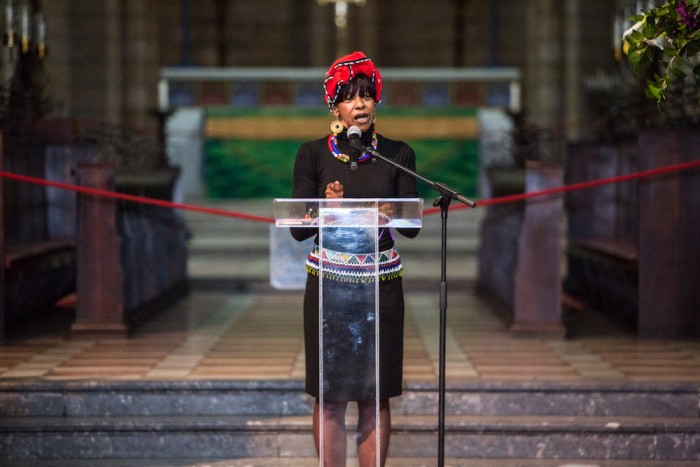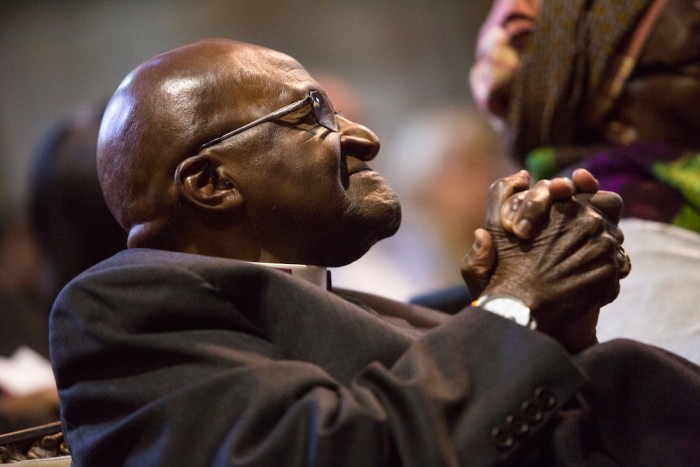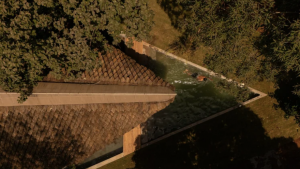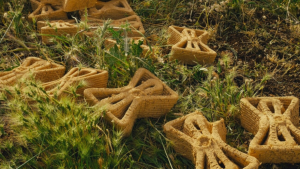Piyushi Kotecha, CEO of the Desmond & Leah Tutu Legacy Foundation talks to Design Indaba founder, Ravi Naidoo on how and why the Arch for Arch was created as a beacon of peace and democracy in honour of revered and much-loved spiritual leader, icon of hope, and Nobel Peace Prize honouree, the Archbishop Emeritus Desmond Tutu.
CEO: What does this piece signify?
Naidoo:
This project holds special significance and is one of the city’s most collaborative and poignant public works. The piece celebrates Tutu and the legacy of love and joy he’s built, as well as the role of art to bring about social change and serve as a catalyst to questions like ‘Where are we?’, ‘Where do we want to be?’, and ‘How do we get there?’.
CEO: What catalysed the project into being?
Naidoo:
It was born out of a different concept entirely. I had initially been approached by the mayor of Cape Town at the time, Patricia de Lille, to help fund and commission a mural of Tutu on the side of the Civic Centre. The Arch was proposed as a more engaging way to honour the Archbishop Emeritus. I said to De Lille at the time: ‘Don’t ask a designer to design you a bridge – ask a designer to get you across the river!’
I met with renowned architecture firm Snøhetta’s founder Kjetil Thorsen whilst in Norway speaking at a conference, and this seeded the start of a fruitful collaboration. I shared a bit about our projects – past and present – and told him I didn’t just want to invite him to come and talk at the Design Indaba Conference, I wanted to invite him to come and do.
Inspired in part by the many arches in Europe and the proximity of the Nobel Peace Centre visible from the window during our meeting, Thorsen committed to working on the project pro bono, and the Arch for Arch was born. In Europe there are a lot of arches in commemoration of war. But we wanted to create a memorial to peace – and men of peace like Tutu. It had to embody that spirit. That was the point of distinction.
CEO: How did you arrive at the concept behind it?
Naidoo:
Because Tutu was a big part of the new dawn of our democracy, we decided that this needed to celebrate and drive home the importance of protecting it. The idea was to build on the legacy of South Africa’s foremost campaigner for democracy to create a platform for public participation in upholding the Constitution. This entailed a campaign which invited members of the public to contribute commentary on what the Constitution means to them, a cumulative crowd-sourced piece that was aired by Media24 towards the end of the project.
When we started to look deeper, we found a beautiful symmetry within the Constitution itself - 14 lines in the preamble, 14 chapters - and it seemed that the natural thing to do was to create 14 arcs for the Arch, representing the preamble and chapters of the Constitution, one of the most progressive in the world. We want people to remember Tutu’s words to us: ‘If you want to do anything to protect my legacy, protect the Constitution.’ If we protect our Constitution, we protect the democracy. They are two sides of the same coin.
Made from 14 arching strands of wood, each bearing a quote from one of the 14 lines in the Constitution’s preamble, the structure forms a dome signifying the founding principles on which the country is built. In the same way that an arch relies on a keystone to avoid collapse, so too do South African freedoms rely on the structure of the Constitution for stability.
CEO: How did you decide on the location?
Naidoo:
Important for what it represented as well as whom it would allow to engage with the Arch, the site was chosen for its symbolism and accessibility. Poised at a confluence of belief systems, old and new, state and church, the oldest avenue in South Africa proved a poetic landing place – straddling the Archbishop’s seat and the road that leads to parliament. Between the two books and pillars of belief – the Bible and the Constitution.
The week we chose the location was symbolic for us in that it was also that week that the Constitutional Court used its power to censure Zuma. It was a moment of realization of how fragile and yet how powerful the democracy is.
CEO: What were the challenges you needed to overcome?
Naidoo:
Because the site we chose straddles Western Province and National land and different heritage councils, we had to bring together representatives of the Anglican Church, Parliament of SA and City of Cape Town and form a steering committee to navigate the necessary permissions and urban planning hurdles. These ranged from preserving heritage oak trees to conducting an archaeological survey due to the proximity of the site to the Slave Lodge. This compromise between groups, and the working together towards a common goal in itself, is symbolic of Tutu’s legacy.
CEO: How did you go about realizing this project?
Naidoo:
The next phase entailed the nuts and bolts – execution and planning. Enlisting local service providers was a crucial element. While Thorsen was leading the charge, we wanted to involve a local architect – the intellectual transfer and sharing of ideas is such a crucial part of any project we do. So, we enlisted Thomas Chapman of Local Studio, whom we’d worked with in the past. Swissline master carpenters came on board, too, to fashion the timber with Siberian larch, a wood chosen for its capacity to endure and create a long-lasting legacy into the future.
With the Design Indaba Conference looming, a dedication ceremony was planned to pledge the piece to Tutu on the final day, using a carefully crafted replica. Bending wood is no small feat and Thomas found a boat builder - Croatian craftsman Dario Farci - in Joburg to create a scale model based on Thorsen’s design for the final piece.
CEO: Where is the scale model now?
Naidoo:
The replica, which was created for the Design Indaba Conference, currently has pride of place in the gardens of the Constitutional Court of Johannesburg and will form the centrepiece of its soon to be re-landscaped grounds.
CEO: When did you first unveil the project?
Naidoo:
The final day of the 2017 Design Indaba Conference culminated in a joyous celebration with Tutu in attendance, complete with voices raised in song and guests from different walks of life. It goes back again to the core questions of ‘What is design for?’ and ‘Can design shift behaviour?’. Design is about how it serves society and improves the quality of life. In his address on the day, Tutu recalled the destruction of Apartheid saying: “All that we did was articulate your aspirations and remind you that you are not second-hand - you are not a feeble copy but a glorious original.”
CEO: What was your timeline for completion?
Naidoo:
The clock was ticking to fulfil the pledge to have the final piece complete by the Arch’s 86th birthday, on 7 October 2017. With the process taking longer than planned due to the intricate nature of the project, the pressure was on…
CEO: Were there other stakeholders involved?
Naidoo:
Up until then, we at Design Indaba had underwritten the entire endeavour, with no funding support from government. At this point, Liberty came on board as a partner, as a way to mark its 60th anniversary with something more lasting and poignant, and this gave the project its final push to the finish line.
CEO: Please tell us about the official launch?
Naidoo:
The Design Indaba team set about planning the event – a celebration that included speakers and messages of goodwill from around the world sent by such venerable humanitarians as the Dalai Lama and Bono of super-group U2. After the formal tribute, came the unveiling by myself, David Munro, CEO of Liberty Holdings, with Patricia de Lille cutting the ribbon in a final flourish.
CEO: What does the Arch for Archmean for the city, South Africans and the world at large?
Naidoo:
An experiential piece, the Arch for Arch allows anyone to walk through it or seek the shelter it provides. Its symbolism – a beacon of optimism and reminder of the value of the Constitution – is underpinned by its everyday practical use and engagement with the community of Cape Town. A place to meet a friend, propose marriage, do your homework, even wait for your transport, this symbolic piece now forms part of the fabric of the city and local culture – with daily life, special events and cultural education all taking place within its orbit. It’s a communication platform, too – with dedicated WIFI taking visitors on a journey into the backstory and meaning behind it, and tourist guides stopping to tell the story of our democracy to travellers.
CEO: Arch for Arch also houses a sonnet dedicated to Tutu, please tell us about that?
Naidoo:
A dedication to Tutu in the form of a sonnet was also included as part of the final piece, a tribute in words to live alongside the physical arch as a reminder of his contribution to his country. Here it is:
To Archbishop Emeritus Desmond Tutu.
To the man who speaks truth to power,
Who stood always at the heart of the fight,
But shows the power of peace and calm.
To our laughing Archbishop – sometime strident, often tender.
Man of God, and Grandfather of the people
Whose broad shoulders comfort the nation.
We honour you, our Arch, and thank you.
14 lines before 14 chapters, now written on 14 arcs of wood
The bowing wooden arches, at once strong and yielding,
Create a space a sanctuary and stillness for all,
Providing shelter but never blocking the view of the sky.
Archbishop Tutu, much loved, we honour you.
Accept this as our tribute to you.

